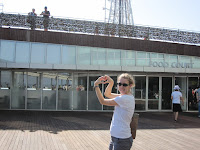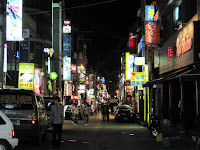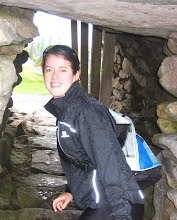I know I haven't yet written about my homestay family, but I wanted to write this lost in translation experience while it is still fresh. All you have to know about my homestay family is:1. the daughters speak English, the parents know a few words
2. the middle school daughter, Chong-een, loves (is obsessed) with Big Bang (Korean pop band), especially their leader G-Dragon.
Yesterday, G-Dragon's solo album, Heartbreaker(see the video--it's interesting!), was delivered. Of course, she was excited! She was really enthusiastic, jumping around, playing music, whatever else a teenager girl would do when her Korean heartthrob deliveries goods. Everyone teased, including me; I called her a "Silly girl" and laughed.
While I was taking a shower, the music, which she had been enjoying abruptly stopped when her mom went in for a talk. Later, her older sister comes to my room saying "different cultures", she is "mere child". Confused? I was. It took awhile for me to understand what happened, especially since the younger daughter was trying to apologize to me. Apparently, my "silly girl" comment was taken seriously by my homestay mother (she recognzed silly); she gave a strict lecture to her daughter about studying, Big Bang's not important, etc. Whether this alone was the cause or whether this only added to her feelings overall, I'm not sure. I felt bad for being the cause, but Chong-een had no hard feelings--she knew I was joking.
Korean Pop Stars Big Bang advertising for Baskin Robbins
As for the reduced frequency in blogposts, I apologize. My attention and time has been taken over by Winter Sonata, a Korean soap opera from 2002. It's a pretty intense love triangle, but Korean dramas are limited in length, unlike American soaps. So all the drama won't go on forever. I only have 10 more episodes, then I'll be free!
 I was on the corner of Jung-ang Rotary in downtown Seoqwipo, waiting for the 5.16 bus (cuts across the island, Seogwipo to Jeju City). It was equally cute to see the little boy grab the handles and put on his game face. As cute as it is, I was also concerned. I don't think I'd buy a scooter or motorcycle here, as Korean drivers can be dangerous. It's supposedly better on Jeju than the mainland, but there's intersections here in Seogwipo without lights or anything else that would seem to govern traffic.
I was on the corner of Jung-ang Rotary in downtown Seoqwipo, waiting for the 5.16 bus (cuts across the island, Seogwipo to Jeju City). It was equally cute to see the little boy grab the handles and put on his game face. As cute as it is, I was also concerned. I don't think I'd buy a scooter or motorcycle here, as Korean drivers can be dangerous. It's supposedly better on Jeju than the mainland, but there's intersections here in Seogwipo without lights or anything else that would seem to govern traffic.











































